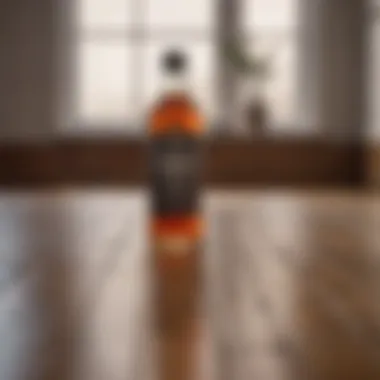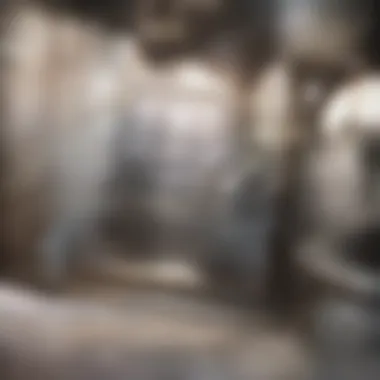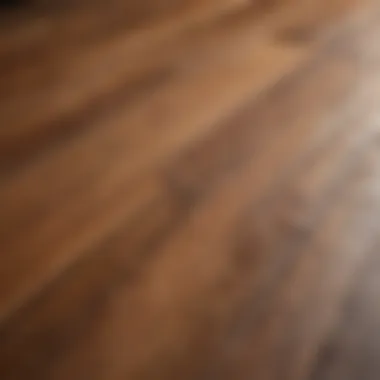Evaluating Vinegar as a Cleaner for Wooden Floors


Intro
The use of vinegar as a cleaner for wood floors has become a topic of interest among homeowners and cleaning enthusiasts. This article takes a closer look at the viability of vinegar in this role. From its chemical properties to specifics on its suitability for various wood finishes, understanding how vinegar interacts with wood floors is crucial for anyone looking to maintain their surfaces effectively. Furthermore, the potential risks involved in using vinegar as a cleaning agent will also be analyzed, ensuring a well-rounded discussion.
Feature Spotlight
Chemical Properties of Vinegar
Vinegar is primarily composed of acetic acid and water. This simple chemical structure grants it unique properties, making it effective for cleaning. The acidity of vinegar allows it to dissolve dirt, grime, and mineral deposits without harsh chemicals. This makes it an attractive choice for individuals looking to clean their wood floors naturally.
Effectiveness in Cleaning
Many users have reported success when using vinegar on their wood floors. Its ability to break down residues is particularly notable. Vinegar can remove sticky spots and mild stains efficiently. However, effectiveness can vary based on the type of wood finish.
Diluted solutions are often recommended to prevent damage. A common ratio is mixing one part of vinegar with three parts of water.
Suitability for Different Wood Finishes
Not all wooden floors are created equal. Understanding the finish on your wood floor is essential before using vinegar. Here are some common finishes:
- Polyurethane: Often resistant to vinegar. Using vinegar is generally safe but always test in a small area first.
- Oil-based finishes: May not respond well to vinegar, as it can degrade the finish over time.
- Waxed floors: Should avoid vinegar due to the potential damage to the wax layer.
Potential Risks and Considerations
While vinegar has many benefits, it also poses risks when used improperly:
- Dullness: Frequent use of vinegar can lead to dull finishes over time.
- Warping: Excess moisture from vinegar can warp certain types of wood.
It is advisable to consult the manufacturer's guidelines regarding care and cleaning for specific wood types.
"Understanding the compatibility of vinegar with your wood floors is essential for effective maintenance."
The End
In summary, vinegar can be a viable cleaner for wood floors if used wisely. A careful approach that considers the floor's finish and potential risks will yield the best results. Homeowners can achieve a balance between cleanliness and the integrity of their surfaces by following recommended practices. This insight aims to equip readers with the necessary knowledge to maintain their wood floors responsibly.
Prelude to Cleaning Wood Floors
Cleaning wood floors is an essential task in maintaining their beauty and longevity. The proper care of these surfaces not only ensures a visually pleasing environment but also extends the life of the flooring. Regular cleaning can prevent dirt buildup, scratches, and other damage that may necessitate costly repairs or replacements.
Importance of Proper Cleaning
Wood floors are a popular choice for many homes. They offer an aesthetic that complements various interior designs. However, improper cleaning can lead to a variety of problems. For instance, accumulated dirt can create a dull appearance and damage the finish. Additionally, certain cleaning agents can strip the protective coating, exposing the wood to moisture and making it prone to warping or discoloration. Following the correct cleaning methods is critical to preserve both the visual appeal and structural integrity of these surfaces.
Common Cleaning Solutions
When it comes to cleaning wood floors, several products are commonly used.
- Commercial Cleaners: These are specifically formulated for wood and often contain a combination of surfactants and conditioning agents. While effective, they can be pricey and sometimes contain harsh chemicals.
- DIY Solutions: Many homeowners opt for do-it-yourself options, such as mixing vinegar and water. This approach is both cost-effective and eco-friendly. However, the effectiveness may vary depending on the concentration and application methods.
- Soap and Water: A mild soap diluted in water can also be useful. It's important to avoid excess moisture, as water can seep into the wood and cause damage.


Each of these solutions has its pros and cons. The choice largely depends on the specific needs of the wood floor, the level of dirt, and personal preferences regarding cleaning agents.
Understanding Vinegar as a Cleaning Agent
Vinegar has been a staple in household cleaning for a long time, but its use on wood floors is somewhat contentious. Understanding the properties of vinegar as a cleaning agent is crucial for homeowners looking to maintain their wood flooring effectively. The following discussion focuses on its chemical composition and how it works to clean surfaces. By comprehending these aspects, one can make informed choices regarding the suitability of vinegar in the cleaning routine.
Chemical Composition of Vinegar
Vinegar typically consists of acetic acid diluted in water, with a concentration of about 4-7% acetic acid in common household vinegars. The remainder is primarily water, although other components can be present in flavored or specialty vinegars. The acidity of vinegar is what makes it so effective as a cleaning agent. It is important to note that the pH level of vinegar is around 2-3, which allows it to effectively break down grime and mineral deposits. The high acidity can also enhance its ability to dissolve soap scum and even certain types of glue residues.
Vinegar's chemical structure allows it to alter the bonds between dirt and surfaces. This mechanism can be particularly beneficial when dealing with oil-based stains which can be more challenging to remove. By using vinegar, users can leverage its natural cleaning properties without resorting to harsher chemical alternatives that could potentially damage wood finishes over time.
How Vinegar Breaks Down Dirt
The effectiveness of vinegar as a cleaner relies on its unique property of dissolving dirt through a combination of its acidic content and its solvent capabilities. When vinegar is applied to a soiled surface, its hydrogen ions interact with the dirt particles, effectively loosening the bonds that hold them to the wood.
This process can be likened to a gentle scrub without the need for abrasive materials that could scratch wood floors. Vinegar can easily penetrate and lift dirt, grease, and residues. For many people, using vinegar is a simple method that does not involve complex procedures or expensive products.
It is also worth noting that the cleaning action of vinegar is not limited to merely removing visible dirt. The penetrating nature of vinegar allows it to access dirt that has settled deeply into the fibers of the wood. After applying vinegar mixed with water, residents often find their wood floors looking noticeably cleaner and fresher. However, it is crucial to ensure that the vinegar is properly diluted to avoid potential acid-related damage to the surface finish over time.
"Vinegar not only cleans, but it also refreshes wood floors by removing impurities without harsh chemicals."
The Effectiveness of Vinegar on Wood Floors
The effectiveness of vinegar as a cleaner for wood floors is a significant aspect of maintaining their appearance and longevity. Vinegar is not just a kitchen staple; it offers various advantages when it comes to cleaning. Its natural properties allow it to tackle common household dirt and grime without resorting to harsh chemicals. Such effectiveness is crucial for homeowners seeking an eco-friendly alternative. By understanding how vinegar performs in different cleaning scenarios, one can make informed choices about their floor maintenance practices.
Removing Stains and Residues
Vinegar can be an efficient solution for removing stains and residues from wood floors. Its acetic acid content aids in breaking down tough soils that accumulate over time. Common stains, such as those from food spills or pet accidents, can be particularly troublesome. A solution of vinegar and water can help lift these stains. However, it is important to note the correct dilution ratio. Typically, a mixture of one part vinegar to three parts water works effectively without risking damage to the finish of the wood.
To apply this solution:
- Use a soft cloth or mop to avoid scratching the surface.
- Dampen the cloth rather than soaking it, as excessive moisture can harm wood floors.
- Wipe gently, allowing the solution to penetrate the stain.
In some cases, stubborn stains may require multiple applications. Testing the vinegar solution in a small, hidden area is advisable before full application. This test ensures that it does not alter the wood finish negatively. Frequent use of vinegar for stain removal can help maintain a clear and attractive surface on your wood floors.
Disinfecting Properties
Another significant aspect of vinegar's effectiveness is its disinfecting properties. While vinegar is not a registered disinfectant, studies indicate it can kill some bacteria and viruses, making it a decent option for routine cleaning. This is especially relevant in high-traffic areas of the home where germs are likely to accumulate.
A solution containing vinegar can be used on surfaces that need to be sanitized, particularly after they have been exposed to dirt or spills. However, for thorough disinfection against all pathogens, it may not replace chemical cleaners designed specifically for that purpose. Yet, the regular application of diluted vinegar can contribute to a cleaner environment.
When using vinegar as a disinfectant, consider the following steps:
- Ensure the floor is free of debris before applying the vinegar solution.
- Use the same dilution ratio as earlier mentioned for cleaning.
- Allow the solution to sit on the floor for a few minutes before wiping it up. This ensures maximum effectiveness against any germs.
Considerations for Different Wood Finishes
When cleaning wood floors, understanding the various finishes applied to the wood is crucial. Each finish presents unique characteristics that can influence the effectiveness of cleaning solutions, including vinegar. It is essential to be aware of these differences to ensure both cleanliness and the protection of the floor's integrity. Below are considerations for three common types of wood finishes.


Unfinished Wood Floors
Unfinished wood floors are the most vulnerable to liquids, including cleaning solutions. They absorb moisture rapidly, which can lead to warping, swelling, and long-term damage. Using vinegar directly on unfinished wood is not advisable. Instead, a dry mop or a slightly damp cloth is often recommended. If vinegar is to be used, it should be heavily diluted.
- Pros: No risk from vinegar, as it's not applied directly.
- Cons: Vulnerability to water and cleaning solutions.
Polyurethane Coated Floors
Polyurethane coated wood floors are relatively more resilient against moisture and spills. These finishes form a protective barrier that helps shield the wood beneath. Vinegar can be effective in cleaning polyurethane finishes when diluted appropriately. The solution should not be overly acidic, which could damage the coating over time. Utilizing this method allows for removal of grime without harming the finish.
- Dilution Recommendation: A common ratio is one part vinegar to four parts water.
Waxed Wood Floors
Waxed wood floors require special attention during cleaning. They are prone to damage from acidic substances, including vinegar. The wax adds a certain sheen and protection to the wood, but too much moisture or an acidic cleaner can strip away this wax. For this reason, it is best to avoid vinegar entirely on waxed floors. Instead, routine cleaning with a dry mop followed by periodic waxing will maintain the finish.
- Caution: Using vinegar may necessitate rewaxing to restore the protective coating.
In summary, the finish on wood floors significantly affects how one should approach cleaning. Proper knowledge will aid in preserving the beauty and quality of your wooden surfaces for a longer time.
Potential Risks of Using Vinegar on Wood Floors
Using vinegar as a cleaning agent for wood floors can have its drawbacks. While it is often praised for its effectiveness and low cost, there are important risks to consider. Evaluating these risks is essential for anyone who wants to maintain the beauty and integrity of their wooden surfaces over time. This section discusses those risks in detail, particularly focusing on etching and long-term damage. Understanding these hazards will help users make informed cleaning choices.
The Risk of Etching
One of the most significant risks associated with vinegar is the potential for etching on wood floors. Vinegar is acidic, which can lead to adverse reactions on certain types of wood finishes. When vinegar is used directly or in high concentrations, it may cause the finish to deteriorate. This etching can create dull spots or even remove layers of the finish, leading to an uneven surface.
- It's vital to remember that not all wood finishes react the same way to vinegar. For example, unfinished or waxed surfaces are more susceptible to etching compared to polyurethane-coated options.
- To mitigate this risk, it is advisable to always dilute vinegar when cleaning. A common dilution ratio is one part vinegar to ten parts water. This can help lessen its acidity while retaining cleaning power.
"Many homeowners believe vinegar is entirely safe, but using it incorrectly can lead to expensive repairs in the long run."
Long-Term Damage
The long-term effects of vinegar on wood floors are another crucial consideration. Over time, repeated use of vinegar can lead to cumulative damage. The acidic nature, even when diluted, can gradually wear down protective finishes. This can expose the wood beneath to moisture and dirt, which may cause warping or more severe issues.
- Regular cleaning with vinegar might also lead to the need for more frequent refinishing of the floors. Refinishing is a time-consuming process, and the costs can quickly add up.
- Users should also be aware that vinegar can interact negatively with other cleaning products. For instance, mixing vinegar with ammonia or bleach can create toxic gases, posing health hazards.
Best Practices for Cleaning Wood Floors with Vinegar
Cleaning wood floors with vinegar can be effective, but it requires attention to detail to avoid damage. Adopting best practices ensures not just cleanliness but also the longevity of the flooring.
The key elements include proper dilution, the right application techniques, and understanding the specific characteristics of the wood type being cleaned. Following these practices enhances the durability of the floor while maximizing the cleaning power of vinegar.
Dilution Ratios
When using vinegar on wood floors, dilution is crucial. Vinegar is acetic acid, which can be too strong in its concentrated form. The general recommendation is to mix 1 cup of white vinegar with 1 gallon of warm water. This provides an effective concentration that can clean dirt without damaging the floor.
- For lightly soiled floors, a weaker solution of 1/2 cup of vinegar per 1 gallon of water can be sufficient.
- For tougher stains and residues, consider using 1 cup of vinegar, but ensure to rinse the floor afterward to prevent any potential long-term damage.
It's important to test this solution in an inconspicuous area first. Each wood type might react differently, and ensuring compatibility is essential to prevent discoloration or etching.


Application Techniques
The method of applying the vinegar solution matters significantly in preserving wood floors. Here are some practical techniques:
- Mop or Cloth: Use a microfiber mop or a soft cloth. These materials are gentle on wood surfaces and do not scratch or leave lint behind.
- Avoid Oversaturation: Dip the mop or cloth in the solution and wring it out well. Excess water can seep into the wood, causing warping or swelling. The mop should be slightly damp rather than wet.
- Work in Sections: Cleaning one section at a time allows for better control and prevents puddles from forming.
- Rinse: After the solution has been applied, rinsing the floor with clean water helps remove leftover vinegar residue. This step is critical to maintain the finish of the wood.
Properly diluted and applied vinegar can effectively clean wooden floors without causing harm, fostering a thorough cleaning routine.
These application techniques, combined with the correct dilution ratios, ensure that the cleaning process is both efficient and safe for wood floors. By understanding how to use vinegar correctly, homeowners can maintain their wooden surfaces effectively.
Alternative Cleaning Solutions
In the pursuit of maintaining wood floors, considering alternative cleaning solutions is essential. While vinegar offers many advantages, it is not the sole contender. Different cleaning products may serve distinct purposes or be better suited for specific scenarios. Exploring various options allows homeowners to make informed choices based on effectiveness, safety, and compatibility with their wood finishes.
Commercial Cleaners
Commercial cleaners designed explicitly for wood floors often feature formulations optimized for safety and effectiveness. These products usually have pH-balanced formulas, ensuring they do not harm the floor’s finish or etch the wood surface. Many of these cleaners offer a range of benefits:
- Specialized Formulations: These cleaners are often crafted with ingredients that target dirt, grime, and allergens specific to household environments.
- Easy Application: Many commercial cleaners come in convenient spray bottles or ready-to-use formats, simplifying the cleaning process.
- Brand Reliability: Established brands tend to invest in research and development, ensuring their cleaning solutions maintain a high standard of effectiveness and safety.
However, homeowners should carefully read labels. Ingredients can vary greatly, and it is useful to select a product that does not contain harsh chemicals.
DIY Solutions
On the other hand, DIY cleaning solutions can be equally effective for maintaining wood floors. These solutions allow for customization and can often be made with common household ingredients.
Some popular DIY options include:
- Mild Soap and Water: A mixture of gentle soap and warm water can be effective for cleaning without damaging the finish. Mix a few drops of soap in a bucket of water to create a lightly soapy solution.
- Olive Oil and Vinegar Mix: Combining olive oil and vinegar can aid in conditioning and cleaning. Use a quarter cup of vinegar with a cup of olive oil, which will enhance shine.
- Baking Soda Paste: For stubborn stains, baking soda can be mixed with water to form a paste. It works well for removal, though caution is advised due to its mild abrasiveness.
While DIY solutions can offer versatility and cost-effectiveness, users must be mindful of their wood floor's specific finish. Not all homemade mixtures are suitable for every floor type.
Ultimately, whether opting for commercial cleaners or DIY solutions, it is crucial to remember that the right cleaning agent can extend the life and beauty of wood floors significantly. Balancing effectiveness, safety, and material compatibility is key to achieving the best results.
End on Using Vinegar for Wood Floors
The topic of using vinegar as a cleaner for wood floors is important due to its widespread mention in many cleaning discussions. It raises the need to understand both the effectiveness and risks involved in such a common practice. Vinegar is often considered a natural alternative to many commercial cleaners. However, it’s crucial to understand that its use on wood floors is not without concerns. This conclusion aims to synthesize insights from the article, emphasizing key elements about vinegar's viability.
Summary of Findings
The examination of vinegar reveals several noteworthy findings. First, vinegar is primarily composed of acetic acid, which allows it to break down dirt and grime effectively. The presence of this acid aids in stain removal and can even address some disinfecting needs, although it is not a full-fledged disinfectant.
Using vinegar may enhance the appearance of your wooden floor, but caution is advised based on the finish of the floor. For instance, unfinished wood absorbs moisture, which may lead to damage when vinegar is applied. Similarly, specific finishes, like wax, do not withstand vinegar well, leading to potential deterioration. The review indicates that while vinegar can be a cost-effective cleaner, it carries risks such as etching and long-term damage to certain types of wood finishes.
Considerable care must be taken when using vinegar on wood floors. Each type of finish behaves differently with vinegar, making suitability an essential consideration.
Final Recommendations
In light of the findings, several recommendations emerge for those considering vinegar for wood floor cleaning. First, only use vinegar on polyurethane coated floors, as these are more resilient. When opting for vinegar, always dilute it with water. A safe ratio is typically one part vinegar to four parts water. This dilution helps reduce acidity while retaining cleaning effectiveness.
Additionally, before applying vinegar broadly, conduct a spot test on a hidden area of the floor to assess any adverse reactions. If any negative effects occur, refrain from using vinegar on that surface.
For those looking for alternatives, consider commercial cleaners specifically designed for wood floors. These products often offer formulation tweaks that allow safe and effective cleaning without damaging surfaces. It is essential to prioritize floor health, balancing cleaning effectiveness with long-term care.
In summary, vinegar can be useful under the right conditions, but it is not universally recommended for all wood finishes. Homeowners should analyze the composition of their floors to make an informed decision.







